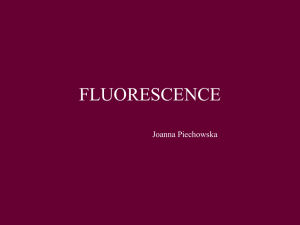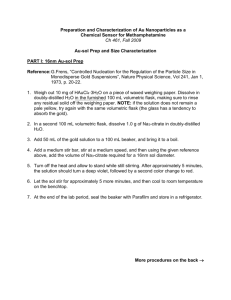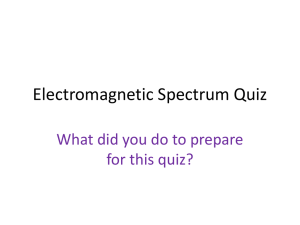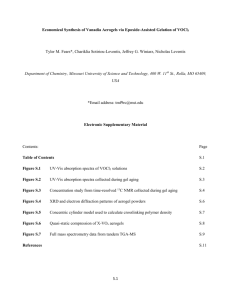View/Download
advertisement
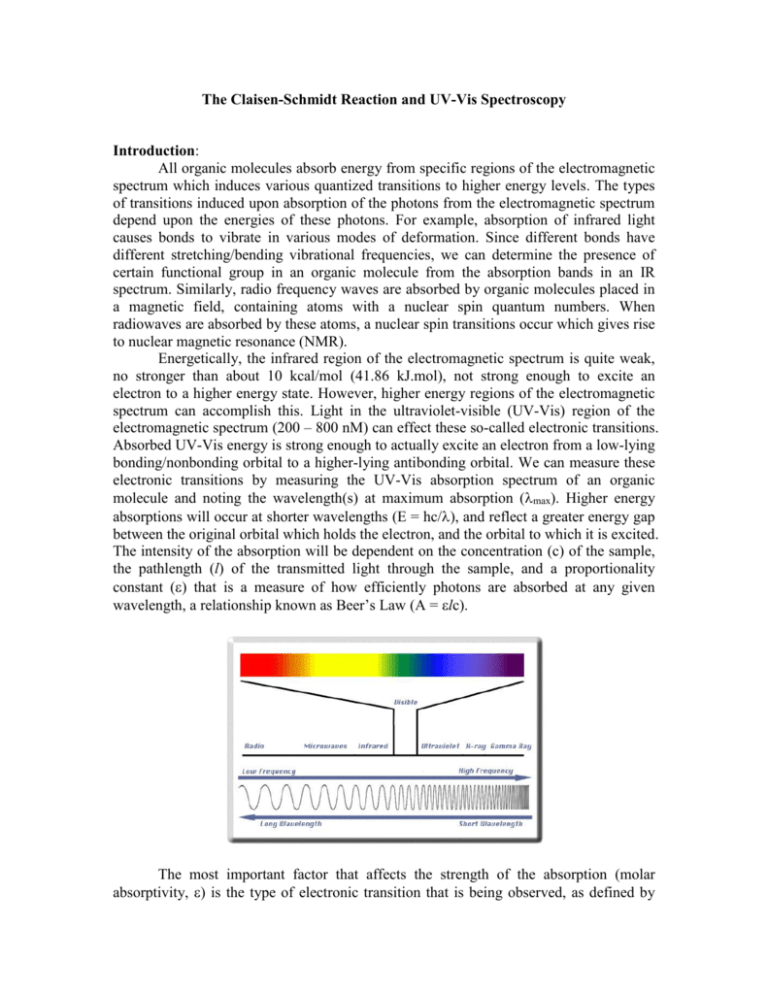
The Claisen-Schmidt Reaction and UV-Vis Spectroscopy Introduction: All organic molecules absorb energy from specific regions of the electromagnetic spectrum which induces various quantized transitions to higher energy levels. The types of transitions induced upon absorption of the photons from the electromagnetic spectrum depend upon the energies of these photons. For example, absorption of infrared light causes bonds to vibrate in various modes of deformation. Since different bonds have different stretching/bending vibrational frequencies, we can determine the presence of certain functional group in an organic molecule from the absorption bands in an IR spectrum. Similarly, radio frequency waves are absorbed by organic molecules placed in a magnetic field, containing atoms with a nuclear spin quantum numbers. When radiowaves are absorbed by these atoms, a nuclear spin transitions occur which gives rise to nuclear magnetic resonance (NMR). Energetically, the infrared region of the electromagnetic spectrum is quite weak, no stronger than about 10 kcal/mol (41.86 kJ.mol), not strong enough to excite an electron to a higher energy state. However, higher energy regions of the electromagnetic spectrum can accomplish this. Light in the ultraviolet-visible (UV-Vis) region of the electromagnetic spectrum (200 – 800 nM) can effect these so-called electronic transitions. Absorbed UV-Vis energy is strong enough to actually excite an electron from a low-lying bonding/nonbonding orbital to a higher-lying antibonding orbital. We can measure these electronic transitions by measuring the UV-Vis absorption spectrum of an organic molecule and noting the wavelength(s) at maximum absorption (max). Higher energy absorptions will occur at shorter wavelengths (E = hc/), and reflect a greater energy gap between the original orbital which holds the electron, and the orbital to which it is excited. The intensity of the absorption will be dependent on the concentration (c) of the sample, the pathlength (l) of the transmitted light through the sample, and a proportionality constant () that is a measure of how efficiently photons are absorbed at any given wavelength, a relationship known as Beer’s Law (A = lc). The most important factor that affects the strength of the absorption (molar absorptivity, ) is the type of electronic transition that is being observed, as defined by the identities of the two molecular orbitals (MOs) that are involved. The two most common electronic transitions in simple carbonyl compounds are the n,* and ,* transitions. The n,* transition is typically much weaker than the ,* transition in both intensity and energy. In acetone, for example, the two absorption bands at max = 280 nm ( = 12 M-1cm-1) and max = 189 nm ( = 900 M-1cm-1) for the n, * and ,* electronic transitions, respectively, indicate that the ,* transition is 75 times more intense that of the n,* transition. In other organic compounds, this difference is even more pronounced. The energy of the transition (or the difference in energy between the ground state and excited state energy levels) is measured by the wavelength of the absorbed light (max). In ketones and aldehydes, the n,* transitions are lower in energy than the ,* transitions, and in highly conjugated compounds, gives rise to the colors we see in the visible portion of the electromagnetic spectrum. Electronic transitions in the UV-region are a function of the ,* energy gaps, which are larger since the -electron originates from a lower energy bonding orbital in comparison to the non-bonding electron of the n,*-transitions. In conjugated systems, because the -electrons of the double bond are delocalized, the HOMO-LUMO gap decreases as conjugation increases, shifting max to longer wavelengths. The energy difference of this gap is dependent on the energy levels of the HOMO and LUMO, respectively. The gap between these orbitals decreases when more electronegative atoms/groups are present, when the -conjugation is more extensive, or when there is better orbital overlap between bonds. In this laboratory, you will study the UV-Vis spectroscopy of a simple organic molecule found in many commercial products, dibenzylideneacetone, and some simple analogues. You will synthesize the symmetric, highly-conjugated ketone by a reaction known as the Claisen-Schmidt reaction (or aldol condensation). You may recall that in an aldol reaction, an enolate anion reacts with an aldehyde to form a new C-C bond in a ketoalcohol. Under strongly basic conditions, however, elimination of this newly formed alcohol can result in a new -bond according to an E1cb mechanism, producing an enone. By using symmetrical ketones, this reaction can occur twice, on either side of the ketone carbonyl, resulting in the formation of cross-conjugated structures with extended conjugation (see below for structure of dibenzylideneacetone). In this experiment, you will design the synthesis of these analogues on your own, using what you know about the mechanism of this reaction and guided by the laboratory techniques you have learned since the beginning of the year. General guidelines are provided for you in the succeeding pages, along with questions that may be helpful in designing your experiment. A few primary literature references are also provided to help you better prepare. Consider the following scenario for this experiment: A local group has approached you with a proposal for a start-up company that would develop new sunscreens to guard against skin cancer. The group’s main objective is to develop a novel screen with an improved sunblocking power in comparison to those sunscreen lotions already on the market. One member of the group has suggested that a suitable candidate might be obtained by modifying a widely-used active ingredient in many commercial sunscreens, dibenzylideneacetone. Dibenzylideneacetone absorbs strongly in the ultraviolet region of the electromagnetic spectrum due to its extensive conjugation. Since it is known that structural features often have a strong effect on the extent of this -conjugation, the group thinks that a comprehensive study of this scaffold may lead to a more effective sunscreen. Many organic sunscreens can effectively absorb in the higher energy UV-B region (280–320 nm) but are less effective in the lower energy, but more harmful UV-A region of the electromagnetic spectrum (320–400 nm). The group believes that you, as an organic chemist, can rapidly synthesize a wide variety of substituted dibenzylideneacetones which can be screened for their ability to absorb UV light in the UV-A region. You hypothesize that this can be done in two ways, which you will study separately. First, you believe that varying the substitution pattern on the phenyl rings will change the absorption spectrum of this new sunscreen. Second, you wonder whether dibenzylideneacetones containing restricted rotation of the bonds attached to the carbonyl group might enhance their UV-blocking ability. Your task in this experiment will be to synthesize two different dibenzylideneacetone analogues, one cyclic and one acyclic, but both containing the same substitution pattern on the phenyl rings. You will then measure the UV-Vis absorption spectra of these samples, find their max, and measure their extinction coefficients at that wavelength. At the end of the experiment, you will compare these values to those synthesized by other members of the class to form a structure-property relationship. Based on the collective results, you will then recommend a lead structure that has the greatest potential to become profitable for the new start-up company. References: 1. 2. 3. 4. J. Chem. Ed. 2010, 87 (12), 1384. J. Chem. Ed. 1987, 64, 367. J. Chem. Ed. 2001, 78, 226. Can. J. Chem. 1968, 46, 3685. Week 1: Synthesis of Differentially-Substituted Cyclic/Acyclic Dibenzylideneacetones Equipment: Microscale glassware kit HPLC vials NMR tubes and caps TLC plates (small) White-capped vials 1 mL syringes and needles Chemicals: Cyclopentanone Acetone Various benzaldehydes (TBA) Sodium hydroxide Absolute ethanol – 200 mL Deionized water Methylene chloride – 100 mL Chloroform – 100 mL Methanol – 100 mL 95% ethanol – 100 mL CDCl3 Procedure: adapted from J. Chem. Ed. 2010, 87 (12), 1384. Synthesis: You will design your experimental procedure from scratch. Please adhere to the following general guidelines: 1. Your theoretical yield should be between 350-450 mg of product, assuming 100% yield. Scale your reaction accordingly. Use a round bottom flask for your reaction with a total volume of about 5 mL solvent. 2. What is the stoichiometry of this reaction? How are you going to monitor this reaction (if by TLC, what solvent system will you use and what spots do you expect to see on the TLC plate?) 3. Theoretically, how much NaOH is required? Run your reaction with 6.25 equivalents NaOH – why might this make a difference in your results? 4. At what temperature are you going to run this reaction? Thinking mechanistically, in what order might you add your reagents? Thinking practically, in what order might you add your reagents (think about whether your reagents are solids or liquids – this may be different from student to student)? Would reaction exotherms cause you to choose one over the other? Workup: You will also design your experimental workup from scratch. Please ask yourself the following questions before designing your workup. You may need to adjust your workup conditions based on the observations you encounter during the experiment: 1. What is the solubility of your starting materials in EtOH:H2O (1:1) mixtures? Is this what you would expect based on the polarity of the starting materials? 2. Would you expect the product to be soluble in the reaction solvent? If not, how might you isolate your product directly? Would you expect this product as obtained to be completely pure? How might you increase the purity? What temperature solvents are needed for this step? 3. If your product is soluble in EtOH:H2O (1:1) mixtures, how else might you isolate your product? Extraction, distillation? 4. How are you going to dry your product before doing any analysis to ensure that no EtOH:H2O is present? Analysis: Obtain a yield of each product, in addition to a 1H NMR, IR, and UPLC/MS. Save your product in a labeled, white-capped vial at low temperature until the next laboratory session. Pre-Lab Questions: 1. Draw a mechanism for the formation of your cyclic dibenzylideneacetone. 2. Make a hypothesis about which of your two ketones will absorb stronger in the UV-A region. What are the reasons for your choice? 3. Make a hypothesis about which aldehyde from the entire class will absorb strongest in the UV-A region. What are the reasons for your choice? Week 2: UV-Vis Spectroscopy Equipment: Microscale glassware kit HPLC vials NMR tubes and caps White-capped vials 1 mL syringes and needles Test tubes Chemicals: 95% ethanol – 1000 mL Procedure: adapted from J. Chem. Ed. 2010, 87 (12), 1384. Sample Preparation: You will design your experimental procedure from scratch. Please adhere to the following general guidelines and ask yourself the following questions: 1. Dissolve a small sample of each product in 95% EtOH so that the concentration of your sample is 20 mM. This is your stock solution. 2. If your product is not soluble, how might you increase the solubility so that you can make your dilution series? 3. Dilute your stock solution stepwise (10-fold each time) so that you obtain a final concentration of 20 M product in 95% EtOH. 4. How many fold-dilution is this? How many test tubes are required? How much volume is required for each dilution? How are your going to measure the volumes in your dilution series accurately? Analysis: Run a UV-Vis absorption spectrum (200–800 nm) in 95% EtOH. Record the max (if there is more than one, record each value while also being conscious of which value lies in the UV-A region). Save this data on a flash drive which you can convert into a plot of absorbance vs. wavelength for your lab report. Finally, obtain an absorbance reading at this max and calculate the of your product (l = 1 cm) at that particular concentration (technically, extinction coefficients should be calculated at more than one concentration). Submit the rest of your product in a labeled, white-capped vial. Pre-Lab Questions: 1. Roughly how much product is required to make 2 mL of a 20 mM stock solution? 2. Draw a dilution series diagram showing how much solvent is needed to convert 2 mL of a 20 mM stock solution into 2 mL of a 20 M sample? 3. In general, what electronic transitions are most responsible for absorption of UV light? Visible light? 4. Why is 95% EtOH used as the solvent instead of a more nonpolar solvent like acetonitrile? Full Lab Report Additional Questions: (not necessarily in this order) 1. Were your hypotheses from the Pre-Lab in Week 1 correct? 2. Which dibenzylideneacetones had the highest max? 3. Which dibenzylideneacetones had the highest ? 4. Do you observe any trend in max or with respect to the electronic parameters of the phenyl rings? Do electron poor systems or electron rich systems absorb more light? Do electron poor systems or electron rich systems absorb light at longer wavelengths? 5. Can you justify your results with the rules for electronic excitation? In other words, do your results make sense in terms of a HOMO-LUMO gap and the factors that cause this gap to decrease? 6. Is there any noticeable difference between the acyclic and cyclic dibenzylideneacetones? Can you think of a reason why this might be the case? 7. Provide a recommendation, supported by experimental evidence, to the local group for the best sunscreen candidate for a start-up company.
